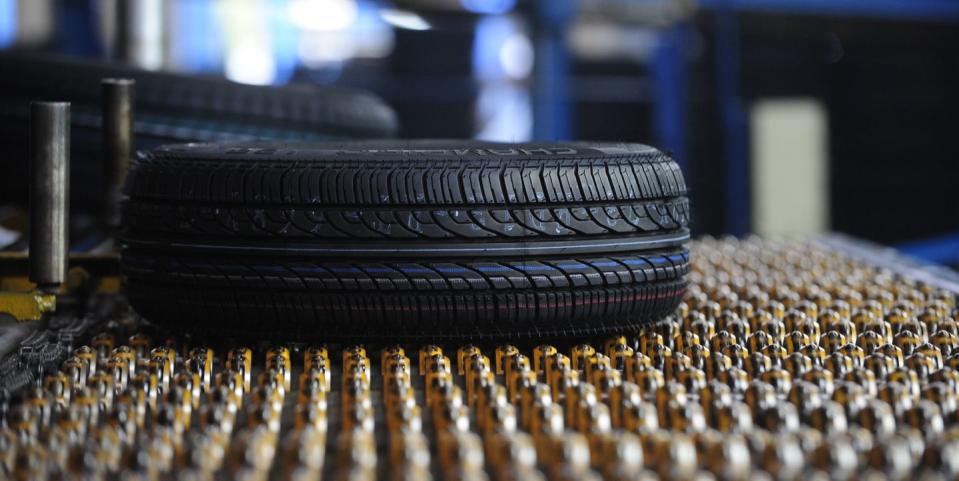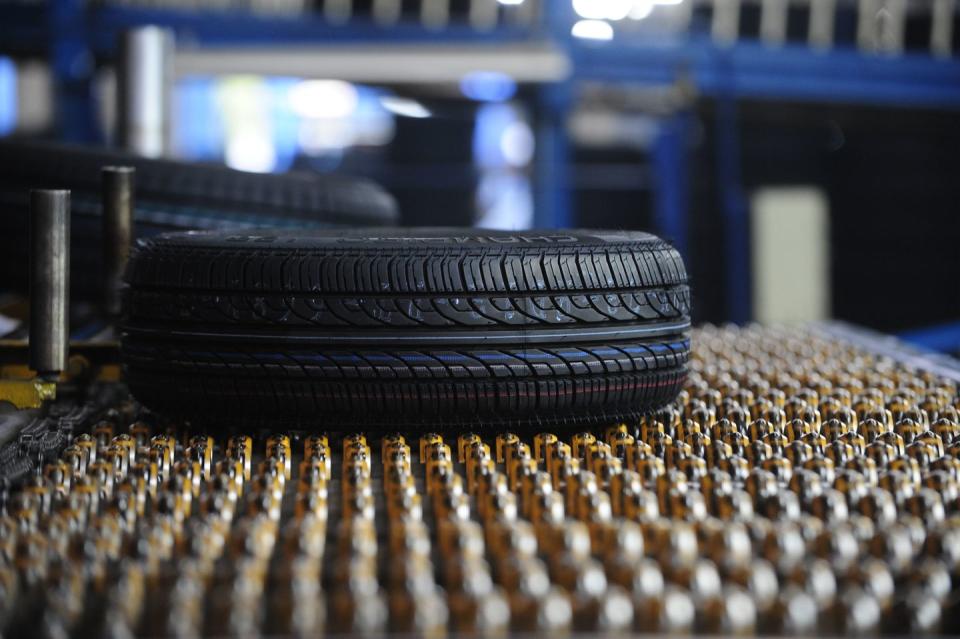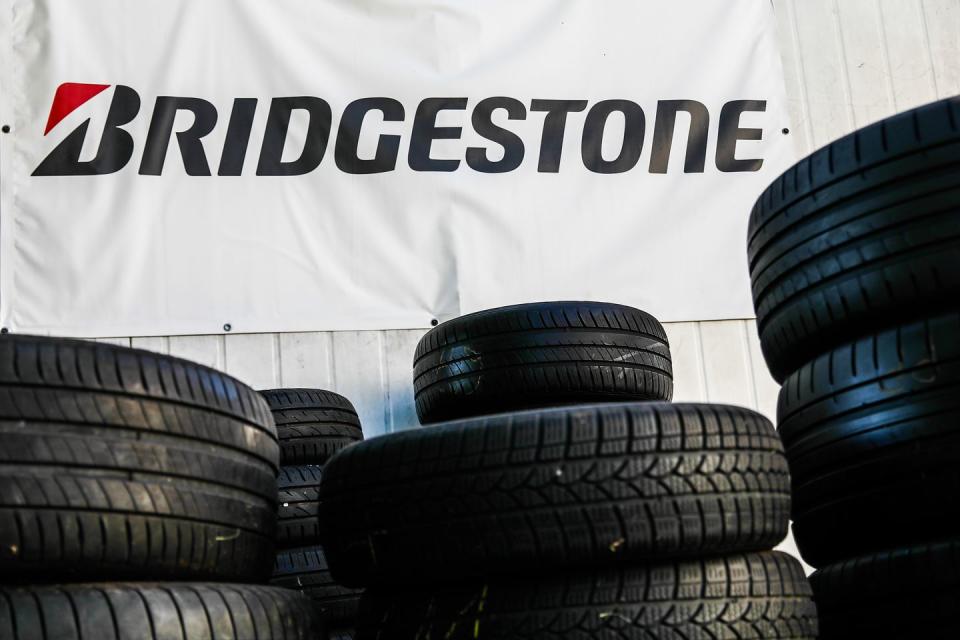How Tire Manufacturers Averted Crisis—and Kept On Rolling

"Hearst Magazines and Yahoo may earn commission or revenue on some items through the links below."

Tire manufacturers have long relied on a stabilizing agent known as carbon black—fluffy, gritty powder produced by combusting natural gas and oils.
Russia has historically led production of this raw material, exporting large quantities of it to tire manufacturers around the world.
Following the Russian invasion of Ukraine and ensuing sanctions, production capabilities and locations were suddenly and severely limited, creating existential crises for some manufacturers.
Trailing the River Volga, a factory combusts and stifles natural gas at 2800°F, smoke pluming around the city of Volgograd. Through this combustion process, fluffy patches of black particles accumulate in the Volgograd factory, as small as 10 nanometers. Formerly known as Stalingrad, Volgograd is a midsize Russian city in the southwest of the country and is home to one of OMSK Carbon Group’s carbon black factories.
Eventually these particles, produced in nearly every world market, make their way into every tire on the road today as a compound known as carbon black. Used as a filler in sidewalls and inner liners, carbon black aids in creating tensile and long-lasting tires due to its heat dissipation qualities and UV protection. Every single tire manufacturer uses carbon black, all sourcing it from various plants around the globe.
Traditionally, these transactions weren’t notable. A raw material supplier fed a product manufacturer that eventually fed consumers. However, in recent years, some analysts sounded the alarm about a shortage of carbon black. Energy producers and journalists correctly predicted carbon-black shortages starting in 2018. Carbon-black production shortages in India and the US choked domestic tire manufacturers and export revenues.
Then came February 2022. Russia invaded Ukraine with a brutal show of force. As much of the world rallied around Ukraine, numerous sanctions were levied against the Russian Federation, aiming to cut off resources and weaken the attacking nation. As a result, many tire manufacturers were suddenly cut off from their supply of carbon black. Autoweek spoke with several tire manufacturers and all confirmed rising raw-material prices while some addressed concerns about supply shortages.
Of course, some brands have relied more heavily on Russian carbon black than others, but there is no denying Russian carbon black has been a cornerstone of the tire market for years. According to World Bank data, Russia was the second largest carbon-black exporter in 2018, shipping over 1.6 billion pounds (worth $680 million) of it around the globe. By comparison, the US was the fourth largest exporter at 414 million pounds in 2018.
Bridgestone reportedly used carbon black from the OMSK factories in Russia since 1991, and Pirelli has had factories in two Russian cities—Voronezh and Kirov—since the 1940s. Now, carbon-black producers and some tire manufacturers are scrambling to make up the difference.
Tire manufacturers rarely create their own raw materials, but multiple producers said they try to source them—specifically carbon black—as locally as possible. In the case of Continental Tires, this will pose challenges domestically and abroad, though each production facility faces unique issues. North American factories use US-produced carbon black and are experiencing shortages due to EPA regulations. Meanwhile, Continental facilities in Europe continue grappling with raw-material shortages stemming from the war in Ukraine.
“As of today, we can continue to produce at our European tire plants,” said Kathryn Blackwell, vice president of communications and marketing at Continental. “However, we are observing that the supply situation for raw materials required for tire production in Europe is further deteriorating in light of the sanctions imposed and the further worsening of logistics bottlenecks.”
As a result, Continental is re-evaluating its production processes on a per-plant basis. Despite production holdups related to environmental regulations and raw-material shortages, Continental says it doesn’t anticipate general availability issues for the time being.
Continental, like many manufacturers, operates factories in and sources materials from Russia. And while Continental has closed and then reopened its factory in Kaluga Oblast, the move represented a small portion of production for the Germany-based company.
Some manufacturers, however, rely heavily on Russian materials and plants. Nokian, the notorious Finnish tire brand, is experiencing a hit to production like no other. According to its first-quarter report, around half of the company’s raw materials were sourced from Russia prior to the implementation of EU tariffs.
“In 2021, Russia represented approximately 20% of Nokian Tyres’ net sales, and approximately 80% of Nokian Tyres passenger-car tires were produced in Russia,” the report reads. “Raw material unit costs (EUR/kg) in manufacturing, including inbound logistics cost, increased by 35% year-over-year, containing negative currency impact.”
In response to the February invasion, Nokian immediately set out to diversify its manufacturing footprint, which includes the long process of transferring certain production lines from Russia to Finland and the US. Nokian also made it clear the company hasn't been and is not a supplier of the Russian army.
Going forward, Nokian will find new sources of raw materials and potentially create new production facilities. “Nokian Tyres is expediting its plans to invest in new production capacity in Europe, and continues to increase production capacity at its factories in Nokia, Finland, and Dayton (Tennessee) US,” the company said. Meanwhile, the company maintained positive sales rates through the end of March.
For some manufacturers, world events have had little effect on production. A spokesperson for Bridgestone Tires said the company hasn’t experienced any production disruptions.

“We monitor all critical raw materials and global logistics closely and do not foresee any impacts to our supply at this time,” the spokesperson said. “Our team will continue to monitor this situation and maintain open lines of communication with all of our key stakeholders to ensure adequate supply and overall business continuity.”
In fact, Bridgestone's adjusted profit margins were up 19% year-to-year in the first quarter. On the company’s earnings call, CFO Masuo Yoshimatsu acknowledged the company faced rising raw material costs and expects to grapple with limited demand from automotive manufacturing production slowdowns. Still, the Japanese company has seen strong sales in North America and Europe.
Tire manufacturers do the heavy lifting that keeps the auto industry rolling, literally. Even before war in Ukraine, the COVID-19 pandemic had negatively impacted tire sales. For online retailer TireRack, business has only recently started to get back on track, said Woody Rogers, vice president of marketing at Tire Rack.
Tires arrive from factories around the world and manufacturers rarely disclose what sort of issues they are having. “We can’t do much about it,” Rogers said regarding manufacturer, transportation, and supply constraints. Still, in the face of many challenges, TireRack is working to provide as much product as humanly possible, and as quickly as possible because tires can become brittle as they age. For anyone driving regularly, Rogers said their tires will likely wear out before they age out.
“Generally, with the timing of supply, things aren’t aging out but actually selling out quickly,” Rogers said. “You aren’t finding aged products on the shelf, at least not from us.” Shipments which used to take five days are now taking two months, but this doesn’t mean those tires are old.
For now, tire production appears stable despite another period of unexpected turbulence. Manufacturers are highly motivated to seek out new carbon-black suppliers. North American manufacturers are relying on a steady rise of US carbon-black production while European and Asian manufacturers are tapping regional repositories.
The market remains volatile. Birla Carbon, a massive shareholder in the carbon-black industry, announced a 15% price hike for carbon produced in North America, effective July 1. The trend has been under way, as charted by US Bureau of Labor statistics data. From April 2020 to present, the producer price index of carbon black in the US has more than doubled, following 20 years of relatively steady price increases.
First-quarter reports suggest many tire manufacturers managed to post positive sales from year-to-year—a facet of the high-demand and low-supply market plaguing the automotive world. As vehicle production encounters logistical bottlenecks and demand remains high, tire manufacturers wondering how long this market dynamic will last may grow impatient and need to rethink their long-term production strategies.
Share your thoughts on how supply chain issues and global conflict have affected the tire industry—or whether your own business has been impacted—in the comments below.

 Yahoo Autos
Yahoo Autos 